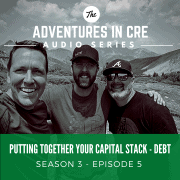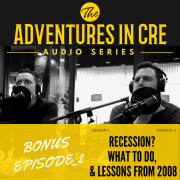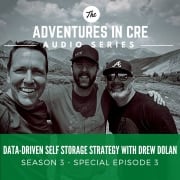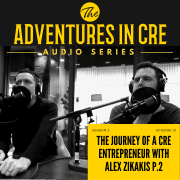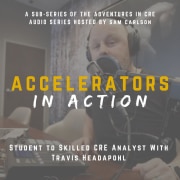The “Secret” to Learning Real Estate Financial Modeling
Just like any skill in life, there are tips and tricks to learning that skill. Some suggestions are more helpful than others, although all contribute in some way. In this episode, we share one of the more valuable tips – what our marketing team has dubbed the “secret” – to learning real estate financial modeling.
And what is that secret? Wait for it……. practice! Big “secret”, I know. But we can’t reinforce this point enough. True proficiency in real estate financial modeling doesn’t come from memorizing formulas or using other people’s models. Mastery comes from learning the right techniques, in the right order, and then practicing those techniques over and over again.
But not all practice is equally as effective. So in this episode, we discuss a few strategies for practicing real estate financial modeling. We then share news about our new Real Estate Case Studies section of A.CRE that we’re launching this month, to help you get the right practice for your area of interest.
The “Secret” to Learning Real Estate Financial Modeling
Watch as Spencer, Michael, and Sam discuss techniques for practicing real estate financial modeling. They also share their thoughts on the new Real Estate Case Studies section on A.CRE.
Or Listen to this Episode
Resources from this Episode
- Library of Real Estate Case Studies: https://www.adventuresincre.com/real-estate-case-studies/
- A.CRE Accelerator: https://www.adventuresincre.com/accelerator
- More CRE Career Advice: https://www.adventuresincre.com/careers/
Episode Transcript – The “Secret” to Learning Real Estate Financial Modeling
Sam Carlson:
Welcome back to the Adventures in CRE audio series today, we’ve got a really special podcast for you. It’s all about the special sauce. The secret to learning real estate financial modeling. Let’s get started.
Announcer:
Welcome to the Adventures in CRE audio series. Join Michael Belasco and Spencer Burton, as they pull back the curtain on everything commercial real estate and introduce you to some of the top minds in the industry. If you want to take your skills to the next level and be part of a growing community of CRE professionals across the world, this is for you.
Sam Carlson:
Hello and welcome back. I’m excited today is special for a lot of reasons, but today we’re talking about the special sauce, if you will, the secret to learning real estate financial modeling, and we hope to make the case for this secret throughout this podcast and to get us started, let’s kick it over to Mr. Spencer Burton.
Spencer Burton:
Yeah. So, you hear these sorts of titles and it’s like, come on secret to whatever, the secret isn’t that big of a secret. Once I say it, it’s so obvious, but I can’t tell you how true this is and that is practice. Okay. The secret to do the reality is it’s practice. Now why are we doing a whole episode on this though? It’s because we’re going to share some ideas and some resources that we’re actually launching this week that will help with this, right? So if practice is the secret, how do you get the practice? We’re going to talk about that. There’s a lot of people who are out of a job right now and it’s, how do you, how does that person get practice? Someone else who’s maybe in a role that they don’t want to be in and they want to pivot to something else, how do they get some practice? By the way, practice is synonymous with experience. How do you get that practice in something else?
And finally, we always frame a learning real estate, financial modeling, and the same way that you learn an instrument. And what’s the way to learn to play an instrument, you practice. Your mom’s been telling you that since you were eight years old, you practice. But let’s start, let’s talk about some ways that you practice and the real meat now that we can get past the sizzle of the secret, this San Francisco, we title this episode. Michael you’re a master at real estate financial modeling. What have you done? What have you done to get there? Like, what are ways that you’ve practiced, both when you were actually working for a big institution, but also when you were a student or when you weren’t working and you’re out on your. Talk to us, let’s get some ideas there.
Michael Belasco:
Sure, sure. So there are a lot of ways to practice real estate financial modeling, as with anything. And Spencer, like you said, it kind of like practicing an instrument, it’s very synonymous. There are a few ways, one of the ways that I think a lot of, I would say our members do on our site is you’ll you’ll download or you’ll get models that you have taken either from maybe it’s our website, or maybe it’s a company that you’re currently working for and you dissect it, you pull it apart and you put it back together. That’s the way to get a real foundational understanding and learn one way somebody is doing financial modeling. You get that over and over again. You get to learn all different types of methodologies and you get to pick and choose your favorite. Now, one way to really internalize that and get fast and become quick is to do things, which is partly what we’re introducing today is to take case studies and maybe time yourself and read the cases and then build them from scratch. So you get a real good foundation.
Spencer Burton:
Well, let me stop you if I could. So before we go, even to the second piece, I really want to focus on this first one about dissecting models. Cause this is an important one. And I also share this advice to a lot of people. So when you say dissect a model?
Michael Belasco:
Yeah.
Spencer Burton:
What does that mean, does that mean you download Michael condo development model and then do what?
Michael Belasco:
Yeah. So let’s take the condo development model. You open that up and you have a bunch of tabs there and it’s, if you’re new to financial modeling, it could look overbearing, but you take it piece by piece. What I would do personally, now looking backwards is, I would go to probably the monthly cashflow tab for example, and you kind of split it out. You have all your cash flows from construction to the operating piece, to the draw schedule. And these are all different sections that you learn to master. So I would go through there and I would go right into the formulas, click F2 so they all light up and can kind of see where they are and just start tracing formulas. Figure out, okay, why is this formula saying this? What is this cell referring to? Pull out the formula and start to rebuild it based on like, not intuition, but like a real understanding.
So not, okay, this number multiplied by this number, it would be, total construction costs multiplied by the interest rate or whatever it is, right. Really start to get the intuition behind it and then take that going forward and just start to rebuild the model. So you break apart sections, you find out where the connections are, rebuild it and then start to understand. Even then when you go to rebuild it, you’re not, it’s not all committed to memory. And again, not all of it has to be committed to memory, but there are key things. For example, if you want to get fast and be able to look at a ton of volume that should be committed to memory, but at the first steps, when you’re deconstructing, it’s all about understanding so that when you look at it again, you’ll be able to understand again. And so really just taking each part, breaking it down, understanding and really creating a framework, not formulas, but of understanding. And so, go ahead.
Spencer Burton:
I love that. And by the way, you and I do this slightly different. So I, it was really interesting to hear how you dissect a model. So my method is I take the model, I’ll go say to your monthly cashflow tab, I’ll convert the entire tab to values. So if you’re unfamiliar with that, you click the arrow in the upper left hand corner between the rows and the columns, and that will select every cell in the workbook. And then you hit control C and then alt hvv, and that will convert the entire thing to values. And then I’ll pull up the template and I’ll have it side by side and I’ll rewrite the formula based on the template file, and my newly created converted to two values file.
And I’ll try to guess what the next formula is going to be. Right? So I’ll start just kind of going back and forth. And the control is that the Tilda is that the keyboard keystroke for converting to formulas, but, or to view formulas. But then I basically just rebuild that tab from scratch. And I try to guess what formula is coming next. If I can’t, then I’ll look and then I’ll write it. And then to your point, they try to understand though, why was the formula written that way? And this is a really interesting way to learn now, by the way, it’s not the most efficient to take models apart and put them back together. It’s kind of the DIY approach, but it’s the approach that I think both you and I, part of our learning to master real estate financial modeling.
Michael Belasco:
Yeah. A lot of people have the mind frame, you want to get there, you want to rush to the finish line and the slower you go and the more you take your time, the faster you get, right? It’s a crawl to understand and if you have the time to do it, it’s amazing. So now better than any, for a lot of our readers and listeners, now’s a great time to be downloading any models you have, download our models. If you have models from work and just breaking them apart and doing these things, there’s many ways to do it, whatever works best. It’s funny, I remember, I think the dynamic draw schedule, I think Spencer, you actually had introduced that to me in one of your models, you had put it and you referenced somebody where you had found a piece of the formula.
And I remember spending a whole night, like I’m talking hours, like I pulled it out and they copied and pasted the formula. And then I tried to figure out how it made it, how it actually worked, like why this was why it was working and why was it working? Now, I don’t know if that it’s almost like the draws, that dynamic cashflow assumption where you got the S curve or bell curve. Whether you need to formally or really internalize that is, is up for question. But the more basic fundamentals of real estate financial mind that you run into repeatedly that helped you make an investment analysis to make you help you make an investment decision. Those are the things that really need to be internalized. So it’s really how deep you want to go. But I would say start with the basics, find out where the most value creation is, and really it’s the formulas that help you make an investment decision. It’s really start to break down and understand.
Sam Carlson:
And I would kind of interject here just a little bit. If you guys look at the reason you started the adventures in CRE website, it was because you were kind of doing this in effect, laborious approach to taking apart these models and deconstructing them. And then you would write about that process and your findings and all those kinds of things. Isn’t that kind of where you started?
Spencer Burton:
Yeah, no, that’s exactly right. It was a combination of things. The first was we were frustrated because there was one or maybe two resources online where you could find models and they were way too expensive. Right. They were really meant to be sold to practitioners. Well, we weren’t practitioners, we were learning. We wanted to learn to take a model apart. And there were very few models available to us. So we’d email people and they would send us a model, always with the caveat, Hey, this is a proprietary model. Please don’t share it with anyone else. It kind of annoyed us. And so we were like, you know what, as we start building models, let’s just share them openly. And if people want to pay great, if they don’t, that’s fine. Right. And that opened up a forum for people to see what an institutional Quality model looks like. And so it’s really good way to learn. That’s not the best way, but it’s one way to learn.
Sam Carlson:
You guys kind of started. And I mean, while you can do it that way, and those resources, obviously you guys have a ton of models available for download that people can go and kind of pick through and really see how they work. And sometimes, I mean, I’ve got kids and they pull stuff apart and they just see how it works. That’s a great way to learn things, but a potentially better way, I think is where we’re going with this, which is some other tools where you can practice. So maybe about the next evolution, either one of you, of learning financial model. And we did talk about some special sauce because practice is special sauce, but not all practice and not all experience is created equally. So let’s move to, what is the better version of this practice that we’ve kind of alluded to so far?
Spencer Burton:
Yeah. So let me first preface this by bringing up how Michael became a master guitarist. Is that a word, guitarist or guitar player, or whatever you want.
Sam Carlson:
You [inaudible 00:21:59] . He is amazing at the guitar.
Spencer Burton:
He really is amazing. And we’ve tried to get him to play on the audio series and he refuses because he’s a humble guy, but he is unbelievable, incredible guitar player. And he’s talked about, I think a little bit on the podcast, how he learned to play the guitar and how you got, how you mastered it, and I’m going to butcher this, but wouldn’t you, you would take a line and you would just play that over and over and over again. You’d listen to it.
Michael Belasco:
Yeah.
Spencer Burton:
Describe that process over again for us.
Michael Belasco:
So I mean, I would sit in my room like a complete hermit in the mountains, so to speak, but just with my tape player back in the day, because CDs, it’s hard to rewind back and forth the tapes you can really hone in. And I would play like, Jimi Hendrix, little wing, right? Like some of the like quintessential amazing guitar songs that you hear. And it’s just, you just fall in love with them. I mean, I fell in love with him personally and I would take five seconds of the song and just rewind it, play it, rewind it, play it, rewind it, play it, until I could figure out exactly what it was and after a while I could play 10 seconds and I can say, okay, I understand when he’s doing 15 seconds and it goes longer and longer, but it takes a while to kind of figure out and get your ear trained to what you’re listening to. But yeah, I’d spent hours and hours just getting in there cause I wanted to duplicate it so much. You know? So it’s really the process for me.
Spencer Burton:
So my whole point of bringing that up, cause I think it’s a really cool story is part of the equation of real estate financial modeling is seeing what a tool looks like. Right? So, and being able to mess around. So someone gives you a guitar, maybe it’s even free and now you can sit there and you can strum, is that a word? But if you don’t have some Jimi Hendrix tapes, you’re going to come up with your own music and you don’t have anything to emulate to really practice with. So I did two years of piano. I was horrible with it, like I just didn’t have the commitment to it. And there was a recital, I think we had every six months we had these recitals and I thought they were the most dumb thing. I learned this one song, Sam you’d know the song, but anyway, I learned one song. Okay. But that was my song, and I learned it and I practiced it. And then there was a time that I had my recital and I played it, and my mom clapped.
In the real estate financial modeling thing. And maybe this is a stretch of an example, but I’m going to use it anyway. One part is the tool, the real estate financial model and taking that model and putting it back together. You learn the other part though, is the song, right? It’s like the model is only so good, is what you’re actually using the model for. Until now, online, if you wanted a case study, either had to find someone on LinkedIn, who’d share it with you in exchange for your email address or you’d have to go poke around WSO like search all their forums and see if someone would share an old Starwood model or something like that. Or a Starwood case study with you, those were your options before, and that just kind of seems silly to us. And over the years, people shared, and I’m a burying your lead, Michael. So I’m going to turn it over to you.
Michael Belasco:
I wanted to draw another parallel here. That makes a lot of sense. So if you look at today and this goes back to guitar playing, if you look at today, anyone that plays guitar seriously can emulate Jimi Hendrix, right? Like he is not hard to emulate these days. However, what he did that was so amazing was he came out of nowhere and brought it to the next level. He brought the guitar playing the next level. And it’s almost like that sang standing on the shoulders of giants where like people open the door, Jimi Hendrix exploded the electric guitar music scene. And then everybody kind of said, Oh, this is how you could play, right. This is how you can do it. This is where this could go. And so now there’s a huge massive library and it’s open, music’s open, it’s easy to follow.
You have so many resources out there. If you want to become a great guitar player, the resources are everywhere, right? And then you have the songs you can just start to learn from. So now, it’s almost a commodity, but guitar players are so much better today than they were back then because they have this huge body of this huge library of music and songs. They can go and look to their favorite guitar players, there’re thousands and thousands and that is something I would say that, I would hope to contribute in this world, this is much smaller music, so creative and financial modeling. So finite today anyway in what you can do with it. But the parallel is that there’s a lot of resources that are now becoming available to help you scale much faster and then take it to the next level, even beyond what others have been doing previously.
Spencer Burton:
Yeah.
Sam Carlson:
Yeah.
Spencer Burton:
So what are we doing? What have you been slaving away for, for the last two or three months. Yeah.
Michael Belasco:
So part and parcel to that is, and what we’re going to launch this coming week is a real estate financial modeling test library, which over the years, Spencer and I have both created and we’ve received dozens of emails with these real estate financial modeling tests. And so what we’re doing is we are creating a library of basically case studies that will either A be synonymous to something you might take. But when you’re trying to get a job or B might be synonymous to a real opportunity, you’re looking at, and you want to do a real quick underwriting up. So we’re going to be releasing an entire library. We’ll start this week with, I would say four or five cases, and then over the coming weeks, we have a bunch that are sort of in the quiver here. We’re just going to keep releasing them over the coming year. So we’ll hope to build this library up to an enormous amount of case studies that people can just access and use as a resource for preparation and training.
Spencer Burton:
Yeah. What I think is cool about it is we’re going to make it searchable in the same way that our library of real estate financial models is searchable. So if you want a case study from a debt shop and multifamily, you’ll just search debt multifamily, and you can hopefully over time, the same way that we built this library that really encompasses every possible, almost every possible scenario out there, you’re able to do the same thing with case studies. The other thing I want to point out for our accelerator members. So a lot of the, for our first, for our non-accelerated members, a lot of the inspiration for the library came from how we develop the curriculum for the accelerator, right? So the accelerator is case based every single course, there’s 16 of them. Plus our ancillary pieces. Everyone is a case based learning mechanism, right?
There’s a case that every task or every concept is framed around. And so we’ve gotten quite good at building cases. And so the library on the front end of the site will be, they won’t be the same cases that are on the accelerator side they’ll be cases that have been shared with us, that we’ve repurposed or that we’ve developed ourselves, but for our accelerator members, great practice. All right. You take the concepts that you learn. We’ll include some, watch me solve back in the accelerator side, but a great way to learn either way, right?
Michael Belasco:
Yeah. And I would say we are, so interestingly enough, through developing this, we’ve actually created a high level methodology to what you can lay over any one of the, no matter what asset class, what risk profile. And so we’ve developed this out, it’s something that we’re sharing with our accelerator members, I’m actually really excited about it. Because over the years of just kind of putting these together, doing our own, there’s sort of these frameworks that can just be played out in every single test that helps speed up the process. And every test is unique and has its own quirkiness and there own metrics and questions. But there’s a general framework that helps, I would say speed up the first, maybe half of the test. So if these are time tests you’re taking for a job, which a lot of these are emulating, then you know, that could be really helpful.
Spencer Burton:
Yeah. And Michael shared with his framework with me, and it’s quite interesting. It reminds me of the frameworks that I’d learned when I was always practicing for the GMAT. And there’s all these frameworks to improve your score. His framework really works. It helps you hone in on what matters and what doesn’t matter in the case. So be on the lookout for that accelerator members. And then in terms of the launch of the library itself, we’re thinking kind of end of June, right? Michael, or am I off on that timing.
Michael Belasco:
End of June? Yeah, I think we’re there, I would imagine. So we’re recording this June 22nd here, 2020. So by the end of this week we should have it up and going with the first couple of cases and we will just continue to build it out over time.
Sam Carlson:
Cool. Well, that is very exciting. Thank you both for doing that. I think the listeners, obviously they get a lot of value from the audio series or maybe from a YouTube if they’re watching, but I’m excited, I think they’re excited. And you guys head on over to the website and we’ll see you on the next episode. So thanks for coming.
Announcer:
Thanks for tuning into this episode of the adventures in CRE audio series, for show notes and additional resources, head over to www.adventuresincre.com/audioseries/. Would you like to learn real estate financial modeling in a matter of weeks and do it with zero guesswork? If so, the ACRE accelerator is for you. The accelerator is a step-by-step case-based program designed to teach you exactly what you need to know, and in the order you need to know it, so you can gain the knowledge and experience to take your career to the next level, to see if the accelerator is right for you. Go to www.adventuresincre.com/accelerator/.

